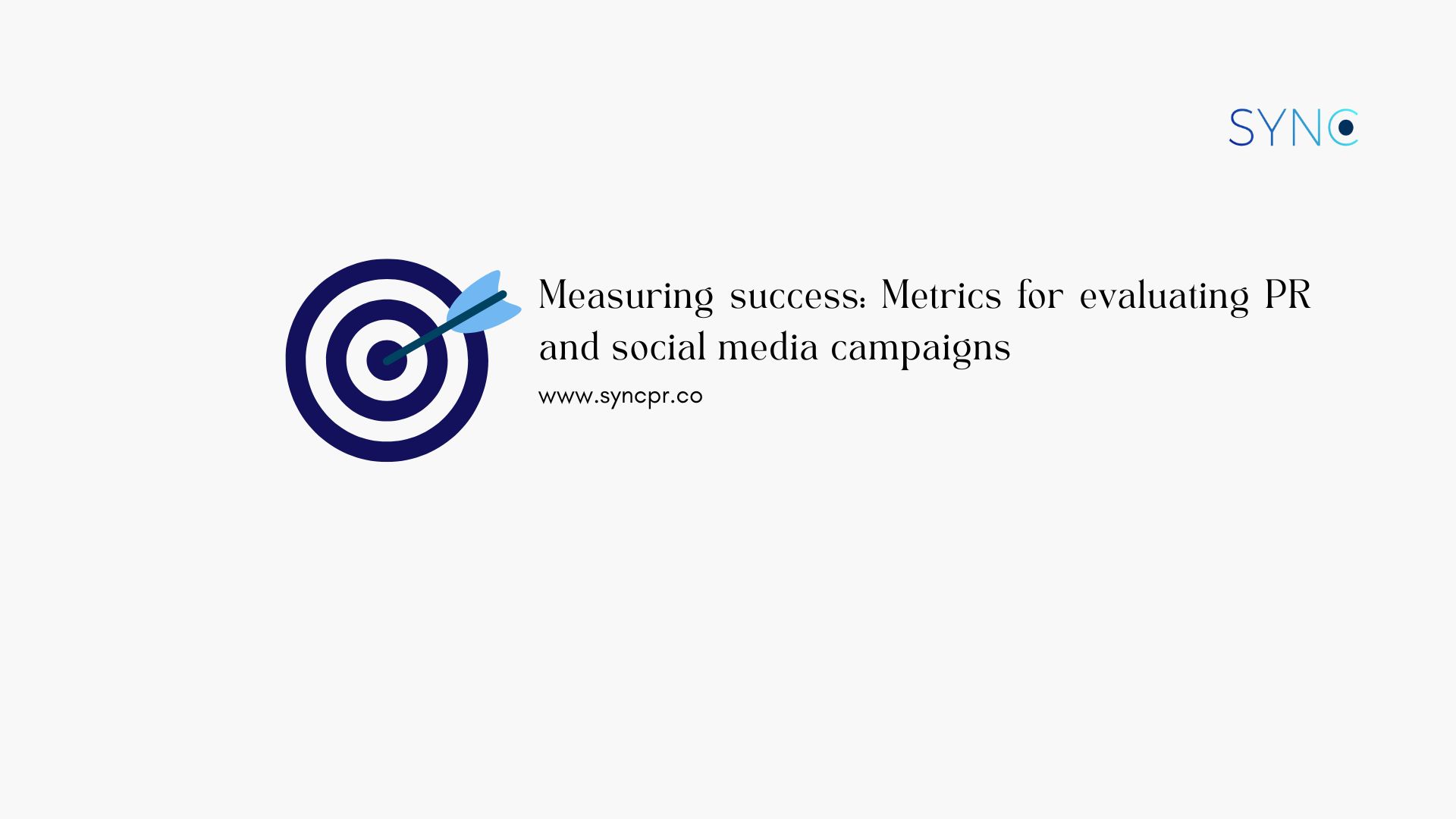Evaluating PR and social media campaigns through different key metrics. The effectiveness of public relations (PR) and social media campaigns is not merely to gauge public attention through creative flair and outreach but also to reach a wider audience and introduce your products to various demographics. The final step of building an effective PR and social media campaign is to track and measure the campaign results. From the thousands of likes, comments, and shares on social media, how do brands go about evaluating PR and social media campaigns and how do they measure the success of the campaigns and convert these numbers into words for the stakeholders and tell them “Hey, the campaign works and we received new customers!”
Evaluating PR and social media campaigns and measuring success is determined by a clear understanding of various metrics that show different facets of the campaign’s performance. For instance, as mentioned earlier, engagement metrics such as likes, comments, and shares preview how audiences interact and engage with specific content – illustrating different levels of interest and resonance.
Meanwhile, reach and impressions metrics quantify the extent of audience engagement – shedding light on the campaigns’ potential impact and visibility within the target demographic across multiple platforms. Not only that, conversion metrics such as click-through rates and lead generation metrics offer tangible insights into how effectively the campaigns are driving engagement and audience action. All these metrics are great for evaluating PR and social media campaigns as they not only quantify the success of the campaigns but also provide further insights which can be used as useful tools for continuous improvement and strategic agility in a competitive digital environment.
Understanding different key metrics for evaluating PR and social media campaigns
When evaluating PR and social media campaigns, one thing that PR professionals and social media managers have to keep in mind is that understanding the key metrics is not necessarily a matter of tracking the numbers but it is also about translating and analysing audience behaviour and perception in real-time. Some examples of analytics tools that can be used for evaluating PR and social media campaigns include Google Analytics and Traackr. These too are great for web traffic insights, and social media platform analytics for engagement metrics.
Transparency to the clients is also important in setting certain expectations. Setting the goals and determining what exactly signifies that your campaign met the goal from the get-go is the key step in evaluating PR and social media campaigns. Does the client want more local newspaper coverage? Or are they looking for more tractions on their website? These are the questions that should be asked when first setting up goals and managing the campaigns, so the measurement must align with the goals.
Metrics for PR campaigns
Effective measurement for PR campaigns rooted in a different set of metrics customised to assess the impact of media coverage and brand reputation. Media impressions are very important in any PR campaign and serve as the basis of the success measurement. Counting the number of times PR content or brand mentions appear across various media channels including websites, local newspapers, and online news sites. A basic understanding of media impressions needs to be in every PR professional’s pocket – this is what usually is covered in the media monitoring scope of the job or a PR professional. On top of that, earned media value (EVM) is a more calculated measurement of the monetary of certain PR coverage. This is based on the advertising rates for multiple exposures. Big publications have a wider reach of audience. Both of these metrics are the key metrics in determining the success of PR campaigns and showcasing the PR efforts in securing various media coverage and putting the brand in the public eye.

Similarly with audience sentiment, share of voice (SOV) measures the brand’s presence in the public compared to other competitors in the market within media coverage. AI-powered media monitoring tools such as Meltwater and Determ are great for tracking SOV, audience sentiment as well as discussion on trends. This is more of a quantitative and qualitative approach to measuring the success of certain PR campaigns. A higher number of SOV means that the brand has a prominent place in the market and influence within the media landscape which assesses the effectiveness of certain PR campaigns as well as good media relations. SOV is used as a benchmark for every PR campaign to measure the brand’s media relations and presence in the market and public eye.
In terms of measuring visibility and brand competitiveness – influence metrics offer a great assessment of the impact of PR campaigns on brand perception. For example, audience perceptions, influence opinions, and expert endorsements on PR campaigns make them stronger and more effective as they have a human aspect to them. Other key indicators that fall under the influence metrics are the relevance and quality of media placements, different authorities of the media publications featuring the brand, and the quality of influencers’ engagement and expert endorsements. These are some of the things that PR professionals need to quantify when measuring the success of PR campaigns through influence metrics.
Metrics for social media campaigns
On the other hand, social media campaigns thrive on audience engagement and interaction. These numbers are important because they represent the success of certain campaigns. Sure, one could argue that these numbers don’t mean anything but we want big numbers, it is always good when the postings are doing well. It means that people are responding to it. Primary metrics are engagement metrics including likes, comments, shares, and the overall interactions received in social media posts. For example, a posting about new lines of sneakers gains high numbers of shares among their followers – compelling enough to be reposted, increasing the reach organically within social media networks.
Beyond the primary metrics, reach and impressions are also important for measuring the campaigns’ overall visibility and exposure. Social media reach measures the total number of unique users who view the content which provides insight into the campaigns’ potential audience size. Impressions, on the other hand, show the total number of times content is displayed which provides the frequency of exposure of the content itself. Both metrics are used to see how effectively a campaign is resonating with its target audience and how frequently the posts are being viewed and engaged.
Conversion metrics are also one of the key metrics in measuring the success of social media campaigns. An example of this is click-through rate (CTR), indicating the percentage of users who clicked on an embedded or attached link or call-to-action (CTA) within a social media post. A high CTR means that the content is well-received by the target audience and encourages them to further explore the brand and its products advertised in the campaign. Conversion rates also measure the percentage of users who completed certain actions on the brand’s websites or social media channels including adding an order into the cart and making a purchase, signing up for a newsletter via email, or filling out a form after clicking through from the social media post.
A qualitative approach to this could also be achieved by sentiment analysis. Sentiment analysis provides audiences’ perceptions and reactions to certain social media campaigns. This metric involves analysing the audiences’ tones and sentiments expressed in the comments section, website or Google reviews, and direct mentions of the brand across multiple social media platforms. Social media managers can leverage sentiment analysis tools such as Brand24 or BrandMentions to learn and understand whether audiences are responding positively or negatively to certain social media posts. Audiences’ sentiments are crucial as provide further insight into brand perception as well as areas of improvement for the brand – which can then help social media managers create more effective messaging that aligns with the brand’s target audience.
Evaluating PR and social media campaigns is important
Effectively evaluating PR and social media campaigns through different key metrics is important as it gives further insight into the brand and at the same time areas of improvement on how to elevate and take the brand to the next big steps. These metrics including engagement rates, audience reach, SOV, and media impressions serve as the benchmarks for any campaigns digitally and traditionally.
Leveraging AI-powered tools for evaluating PR and social media campaigns, such as Meltwater and Traackr is a great way to assess the quantity part of the campaigns which includes numbers and data. PR professionals and social media managers should look into investing in these tools and software, and incorporate them into their campaign strategies planning and stay ahead of the trends.
Want to elevate your brand through effective PR and social media campaigns? Drop us an email at hello(a)syncpr.co – we can help you manage fun and powerful PR and social media strategies.

